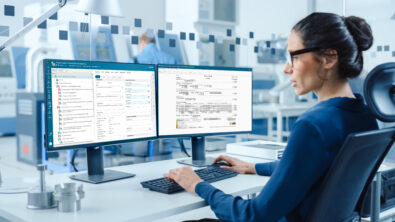⏩ Drive innovation in automotive industry

Automotive insights through a multi-domain integrated BOM
The quest for innovation is the driving force in today’s dynamic automotive landscape. OEMs and suppliers are faced with the challenge of delivering cutting-edge vehicles and vehicle systems that align with rapidly changing consumer expectations. As the industry transitions from hardware-driven to software-centric vehicles, the complexity of development cycles increases, making it imperative for automotive companies to accelerate product development while ensuring quality, cost efficiency, and performance.
The industry is witnessing a shift towards more affordable electric cars, advanced levels of autonomous driving, and expanded vehicle connectivity, leading to an explosion of software content and heightened complexity in next-generation vehicles.
The need for integrated collaboration
Faster decision-making, reduced errors, and increased efficiency are all necessities for driving automotive innovation. Product development stakeholders need access to the same accurate and up-to-date information across all levels of the process – they need a multi-domain information highway.
An integrated end-to-end product collaboration approach allows engineers to work seamlessly across domains such as hardware, software, electrical, and electronics, ensuring continuous communication and alignment. The key to achieving this is a multi-domain bill of materials (BOM).
🔴 What is a multi-domain bill of materials and why is it needed?
A multi-domain BOM is a consolidated information resource that contains all the information and maintains all the relationships between the data elements that support Product Engineering, Manufacturing, and Service. It provides a comprehensive list of components, parts, and materials as well as their quantities across hardware, software, electrical, and electronic domains. A multi-domain BOM facilitates collaboration, real-time updates, product variant configuration, and synchronization of changes across these domains, fostering a unified BOM strategy throughout the product lifecycle.
🟡 Challenges in synchronizing BOMs across disconnected domains
The challenges posed by different release schedules across domains are significant hurdles in maintaining an accurate BOM. For instance, Software teams often have rapid development cycles, while mechanical engineering teams follow a different release schedule. This misalignment can lead to issues such as software incompatibility with the latest hardware, risking the effectiveness of advanced features.
🟢 Value of an integrated multi-domain BOM for automotive organizations
Multi-domain BOM management offers several advantages. First, it enables a detailed digital twin and provides context and traceability across the product lifecycle. You can manage effectivities, create, define, and reuse parts, assemblies, and sub-assemblies, define substitutes and solution variants, define baselines and characteristics, set up service BOM and as-maintained structures, and synchronizes BOM data with other external systems.
It also allows users across the entire lifecycle to manage a common multi-domain definition of product variability, ensuring increased product variation will not drive-up costs. This helps companies develop, maintain, and grow product variants efficiently and promote design modularity by optimizing product configurations for maximized market success.
Finally, automated BOM alignment to Design enables accurate real-time 3D visualization of buildable product combinations, facilitating early validation and Digital Mockup (DMU). Building and visualizing a DMU at any stage of the product development cycle allows decisionmakers to validate, perform clearance analysis, and show carbon footprint data, product cost, and perform assembly level Preventive Maintenance Inspection (PMI). This adaptable, personalized, and cloud-ready BOM solution accelerates innovation by adjusting to customer needs and is available in the cloud for faster, scalable development.
Integrating software into the engineering BOM

One of the key aspects of a multi-domain BOM is its ability to seamlessly incorporate software into the Engineering BOM (EBOM). This allows for a holistic view of product development, aligning software and hardware components within a unified framework. Integrating software with the compatible hardware dependencies is critical to ensure proper execution and vehicle performance, especially for software-defined vehicles.
Consider the development of an Advanced Driver Assistance System (ADAS). In the realm of ADAS, the interplay between physical sensors and software is critical for safety and functionality. The misalignment of release schedules between software and hardware components poses a risk of incompatibility. By integrating software parts seamlessly into the EBOM, automotive manufacturers can address this challenge effectively.
Coordinated CI/CD integration for seamless collaboration
The integration of software parts into the EBOM is not just a theoretical advancement but a practical solution to real-world challenges. A critical factor in achieving this synergy is the implementation of Continuous Integration and Delivery (CI/CD) systems. This automation process captures software deliverables in the BOM, eliminating manual errors and streamlining the integration of software and hardware components.
Connecting CI/CD integration to Application Lifecycle Management (ALM) systems such as Polarion or Jira becomes a pivotal step in achieving cohesion between software development and the broader product lifecycle. This coordination ensures that the latest software advancements seamlessly align with the overall product development process.
Accessing crucial build information
Within this integrated approach, accessing build information becomes a straightforward yet powerful capability. Users can delve into detailed build and job reports through hyperlinks, providing transparency and traceability across software builds within the EBOM.
Embracing the future of automotive innovation
As the automotive industry marches towards a future defined by intelligent and connected vehicles, advanced BOM integration emerges as a critical enabler. By synergizing software and hardware components within the EBOM, automotive manufacturers can not only navigate the complexities of modern design but also set new standards in the competitive automotive market.
Siemens Accelerated Product Development is an open, integrated, and scalable software solution enabling OEMs, suppliers, and new manufacturers to revolutionize development processes through CAD, CAE, simulation, and PLM technologies that work seamlessly together and with third-party applications. It empowers automotive manufacturers with the tools needed to:
- Meet targets and ensure compliance
- Automatically generate the best design upfront
- Virtually validate products and systems
- Successfully deliver today’s complex vehicles
With so many automotive companies racing to develop the next generation of vehicles, innovation will be the critical differentiator that defines who gets ahead and who gets left behind.
Ready to learn about our Accelerated Product Development solution for the automotive industry?


